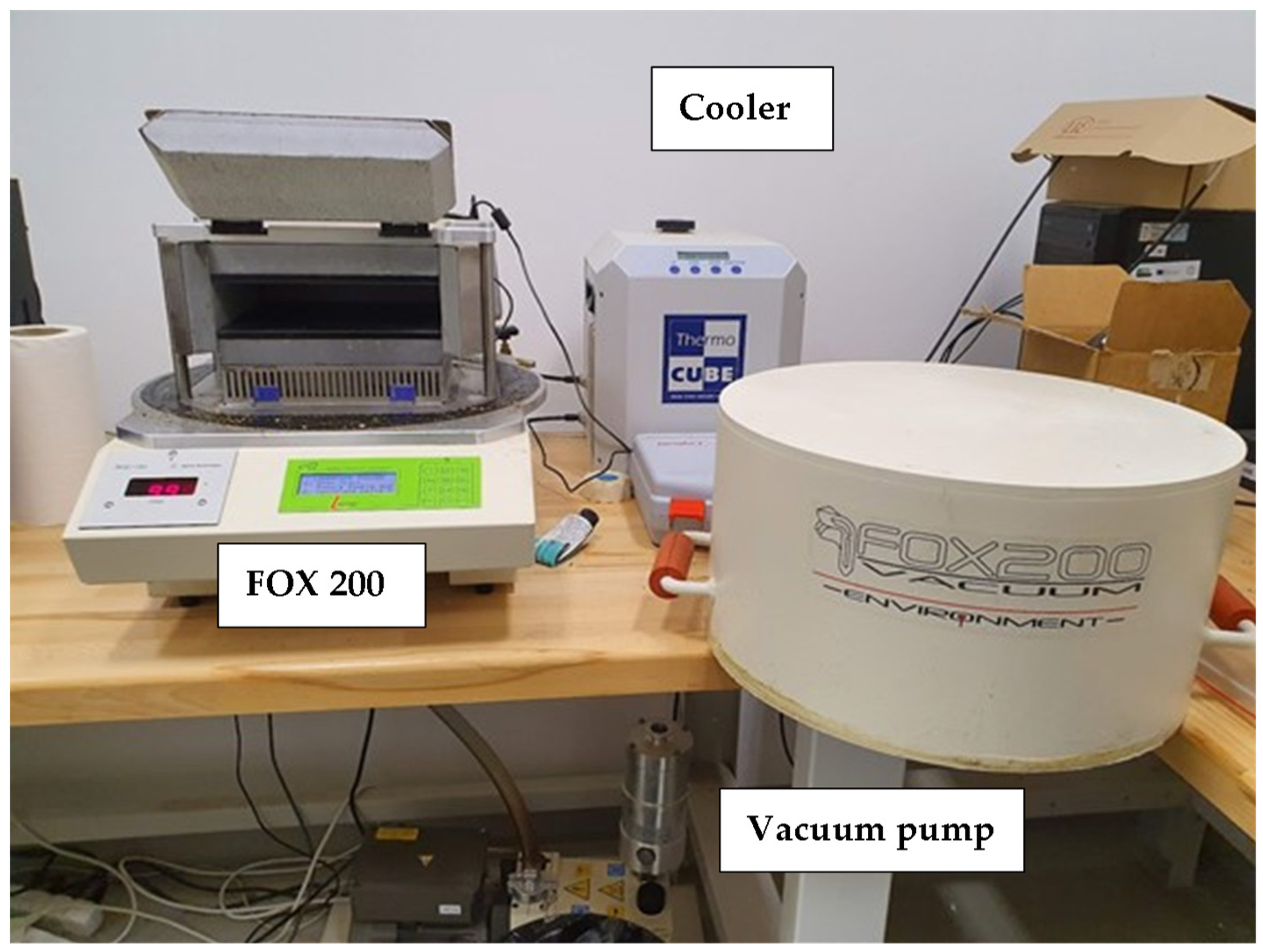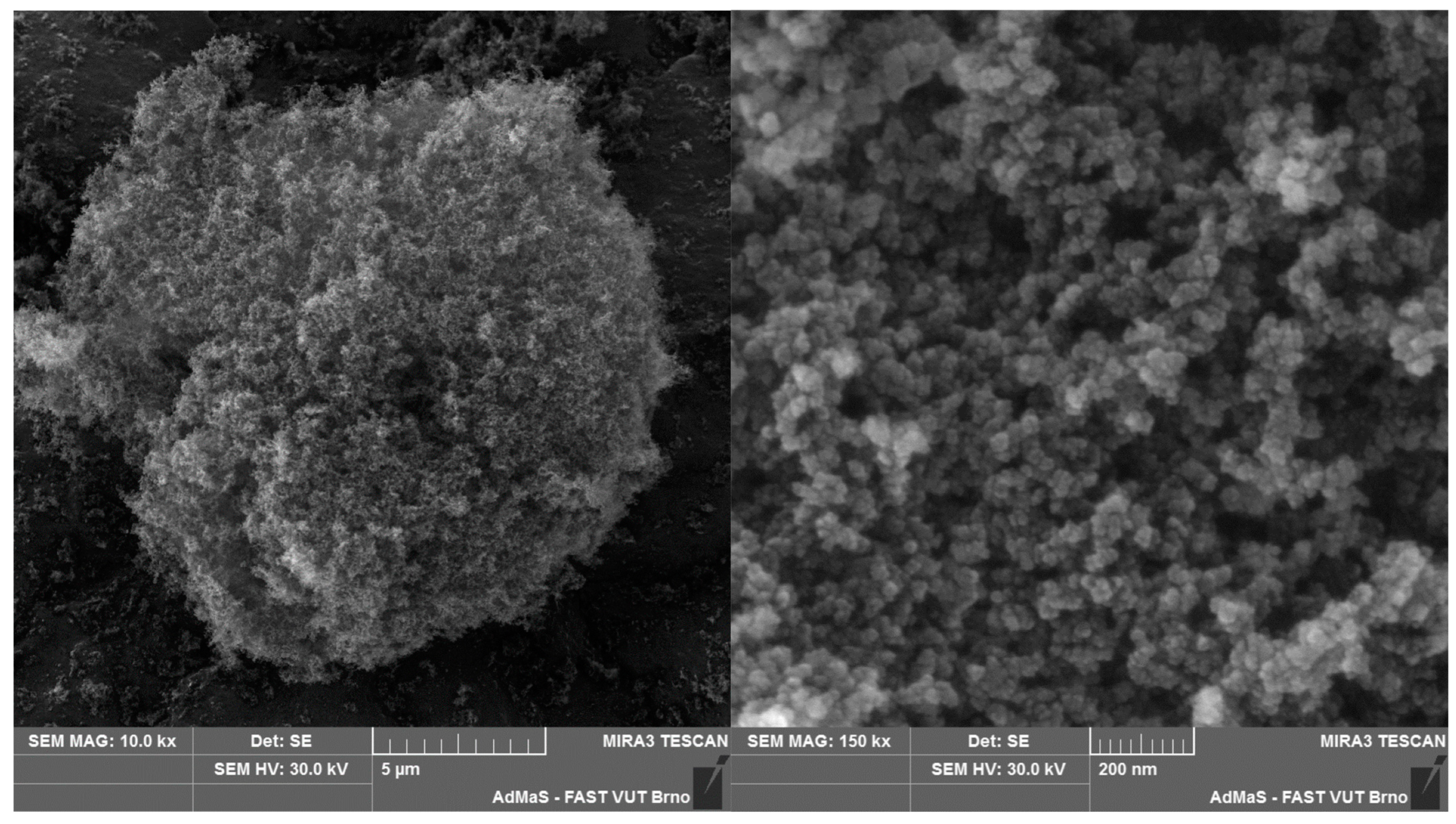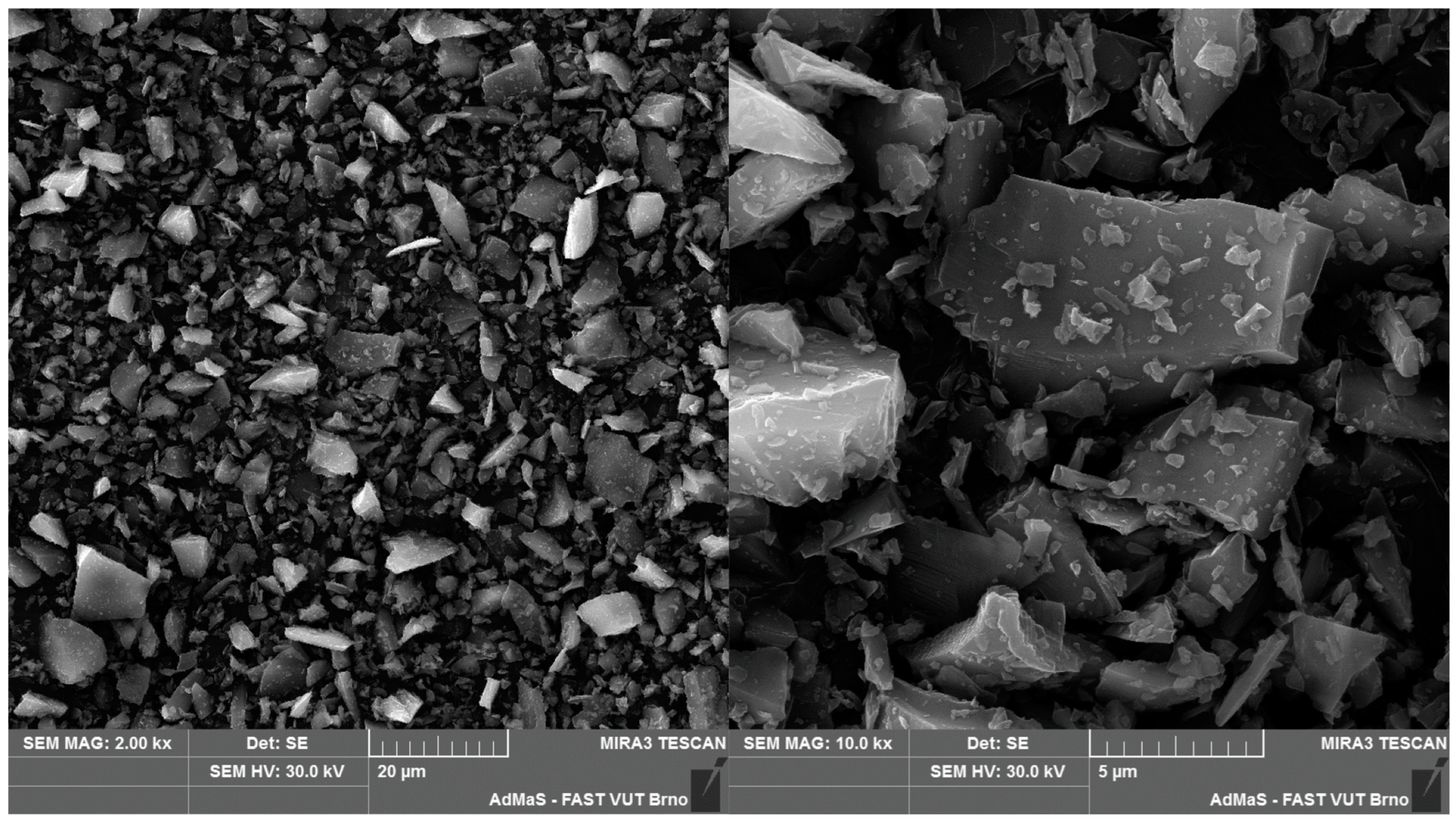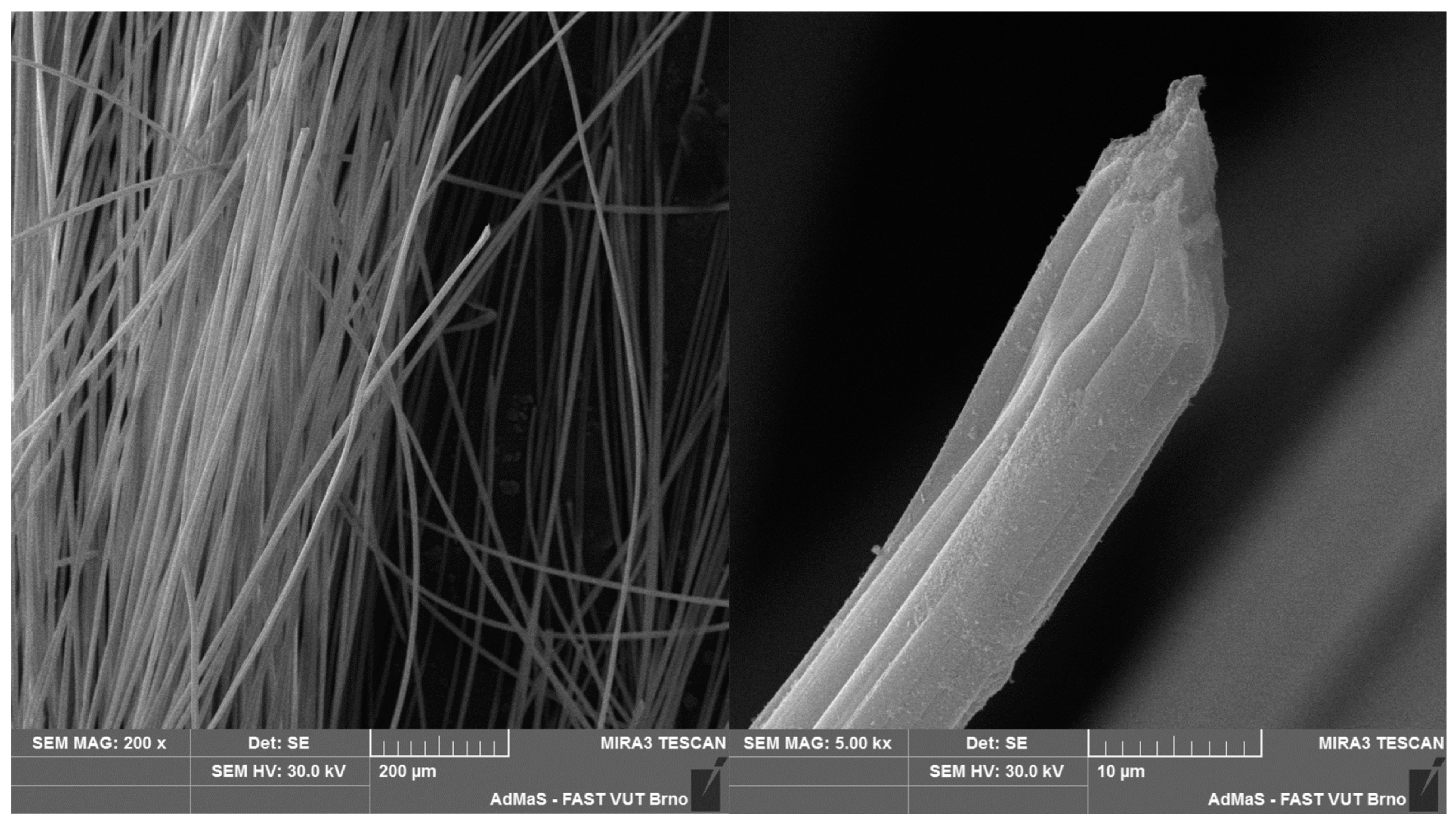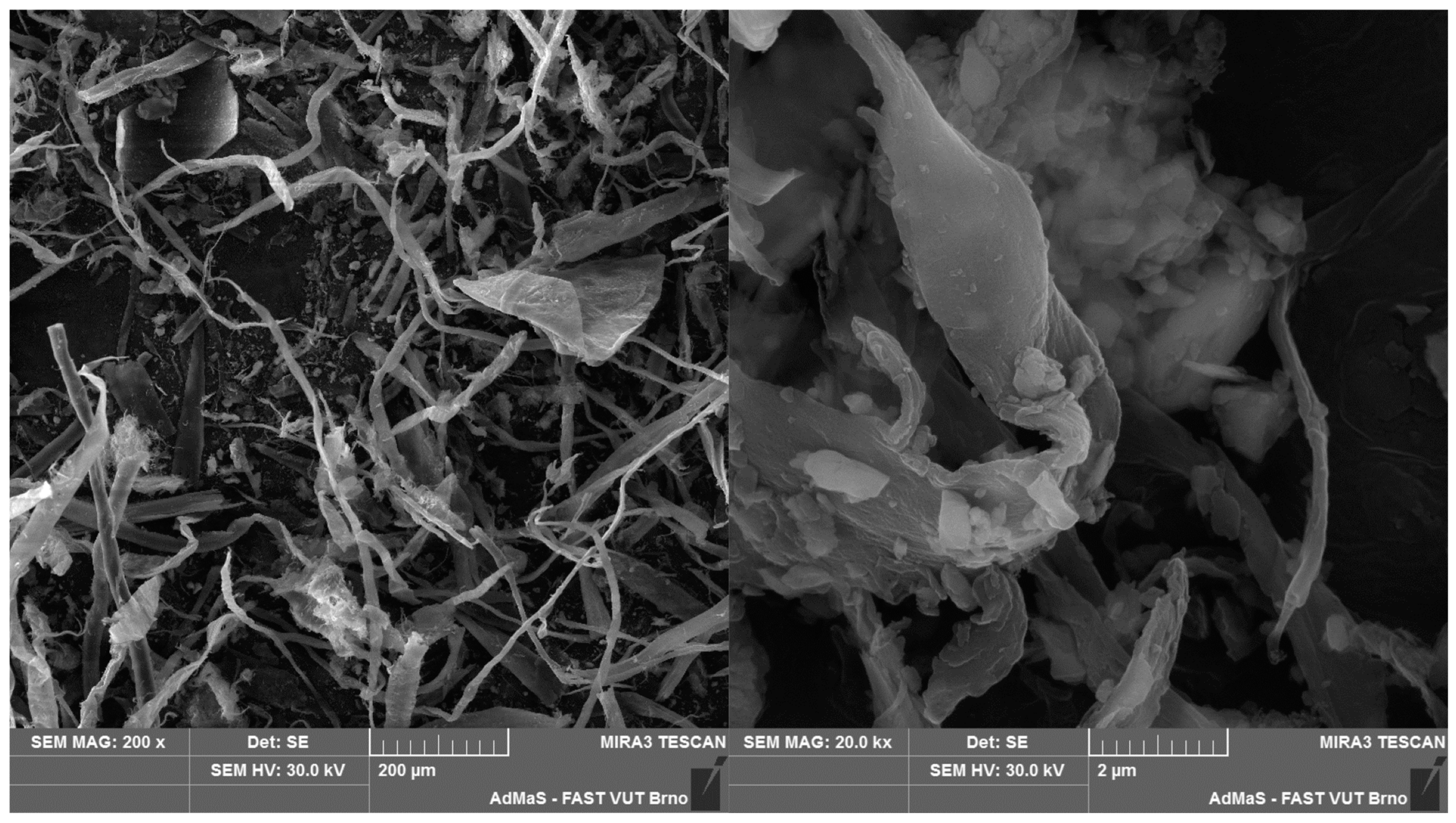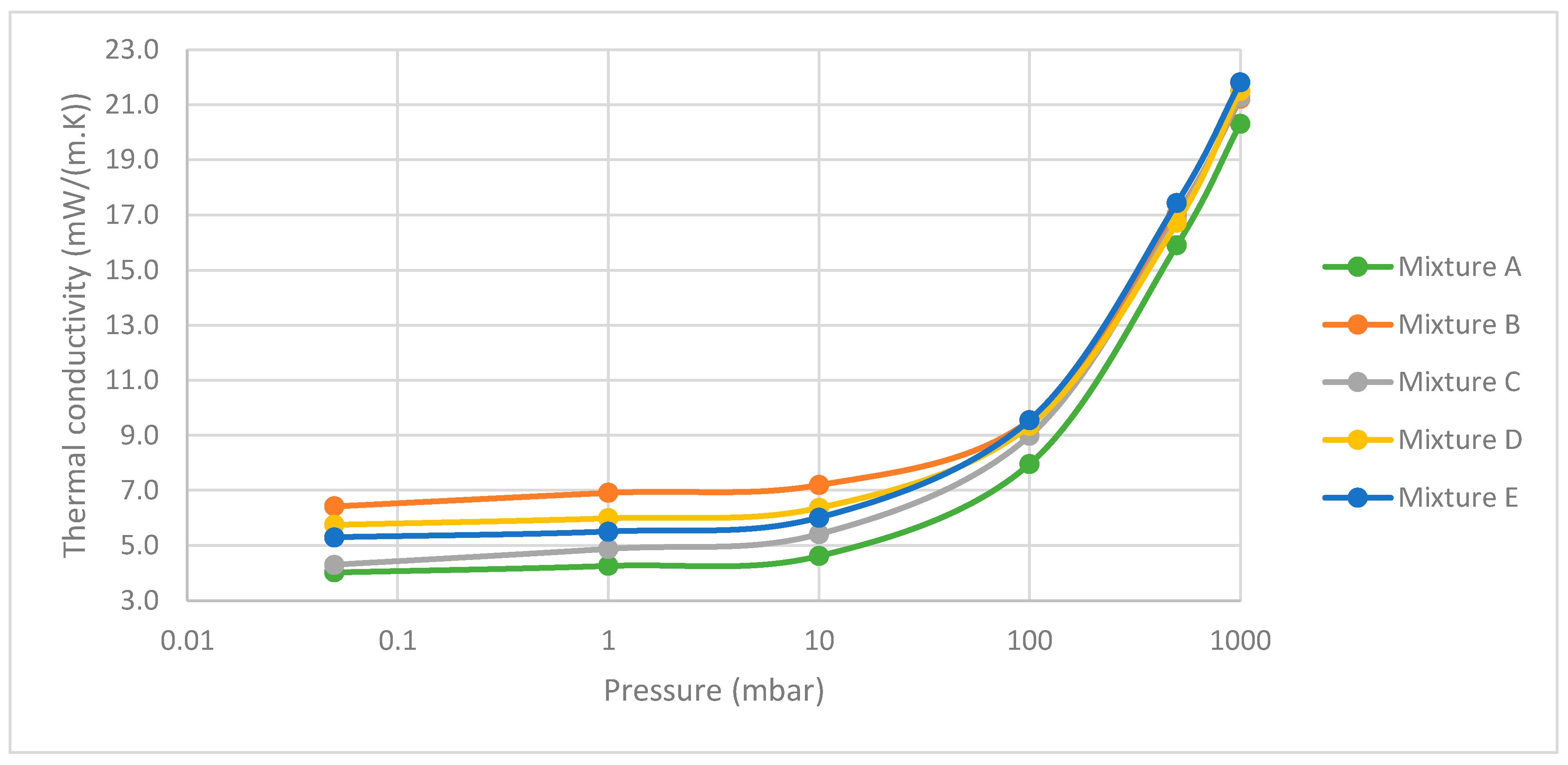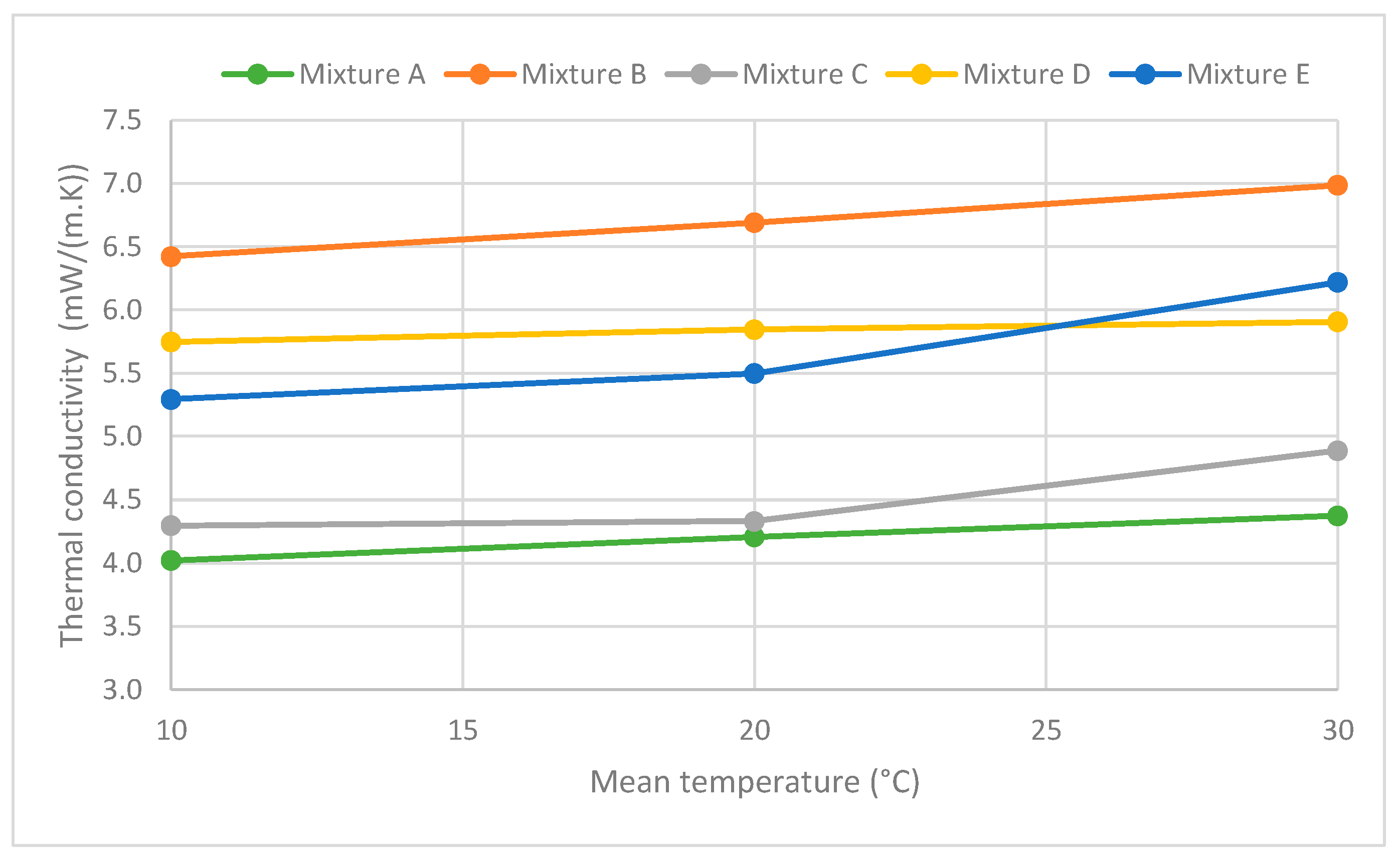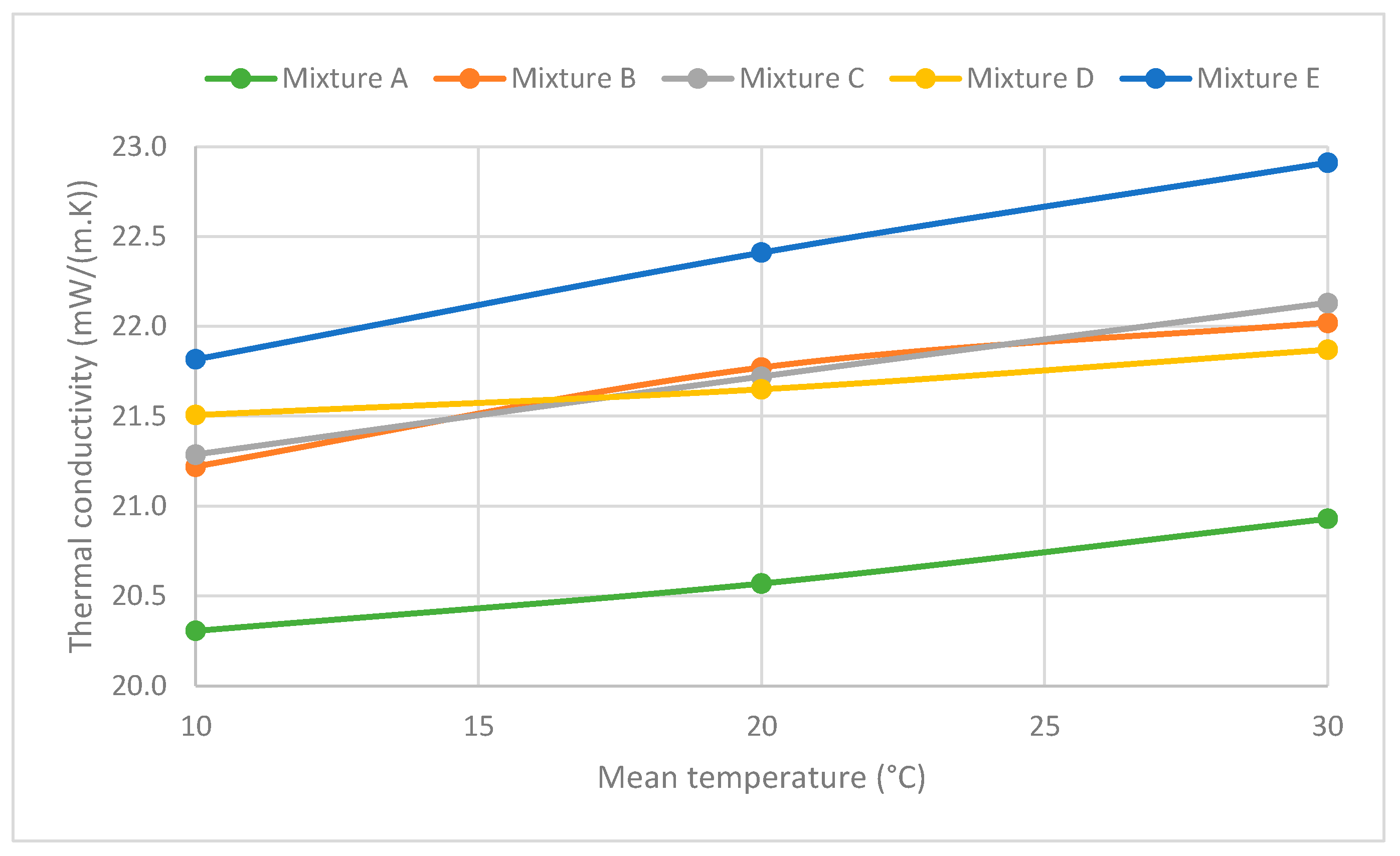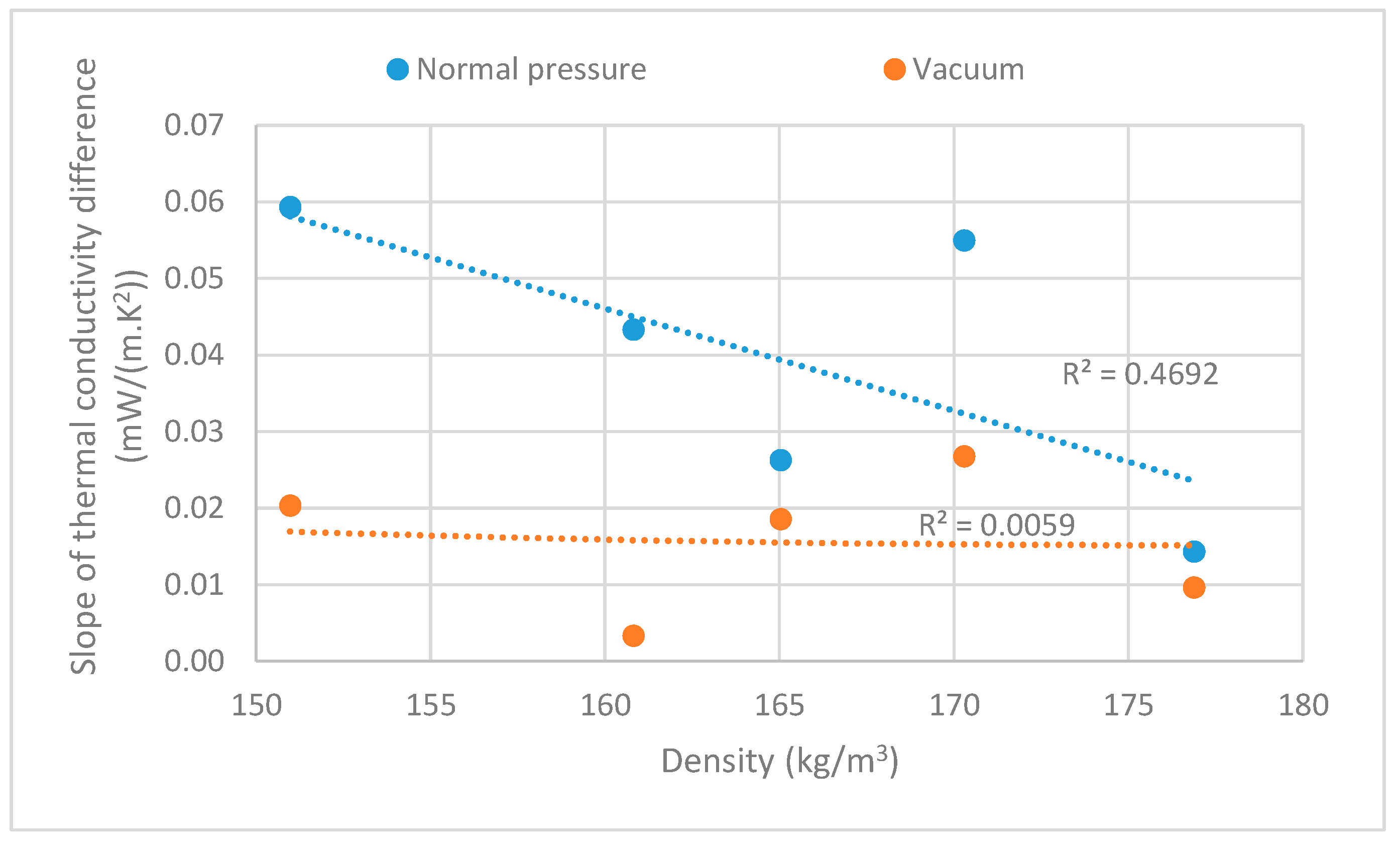1. Introduction
Buildings are among the largest energy consumers in Europe, with an energy consumption of around 40%, consuming more than half of the gas consumption in the EU (heating, cooling of buildings, etc.) and at the same time creating up to 36% of greenhouse gas emissions. Currently, approximately 35% of buildings in the EU are older than 50 years, with 75% of all buildings in the EU even being assessed as energy-inefficient. The reason is mainly the still high use of energy from fossil fuels [
1,
2]. Given the approval of the revision of the Energy Performance of Buildings Directive by the European Parliament in April 2024 (Energy Performance of Buildings Directive EU/2024/1275) [
3], which envisages achieving a zero-emission building stock in 2050, it is necessary to seek and focus on the use of energy-saving solutions in the renovation of existing building structures, in addition to the construction of new passive, low-energy and zero-emission buildings. This includes the use of high-quality building materials with a low carbon footprint.
This extensive renovation of existing buildings and the construction of near-zero-energy buildings by 2050 represent the possibility of using promising superinsulating materials with a maximum thermal conductivity of λ
max 25 mW/(m·K) [
2,
4], which also includes vacuum insulation, which has up to 10 times greater thermal resistance compared to conventional insulation. More than 10 years ago, it was proven on the basis of basic research that, in many cases, these materials represent the only way to achieve efficient energy retrofitting and serviceability of buildings, for example, in the case of the impossibility of reducing the internal environment of buildings [
5,
6].
Vacuum insulation panels (VIPs) represent a new type of thermal insulation material with thermal conductivity in the center of the panel (initial value without aging) in the range of 2 to 4 mW/(m·K) depending on the core material and declared values (including aging for 25 years of service life and edge effect of panels) in the range of 6–8 mW/(m·K) [
7]. In the construction industry, vacuum insulation in the form of boards, which are referred to as vacuum insulation panels (VIPs), is most often used and is manufactured and marketed within the EU in accordance with EN 17140 [
8].
For many years, many research teams around the world have been trying to find more cost-effective and environmentally beneficial vacuum insulation materials that could not only significantly contribute to the renovation of existing buildings, but also be used in the construction of new near-zero-energy buildings. However, these superinsulation materials are completely different from traditional insulation materials from a material point of view, and it is necessary to know and understand their properties, including the mechanism of heat transfer [
9]. This publication presents the results of research work in the field of developing a hybrid core insulation material for the production of VIPs, where it would be possible to use alternative raw materials based on easily renewable raw materials and waste. The aim is to reduce the environmental impact within the monitored parameters according to the Environmental product declaration (EPD) [
10] and maintain comparable utility properties with VIPs based on SiO
2.
1.1. Vacuum Insulation Panels
VIPs are composed (as defined in the product standard EN 17140 [
8] for VIPs for the construction industry) of a porous core, a casing that represents an airtight and vapor-tight barrier and may also contain gas absorbers, so-called getters and desiccants, the purpose of which is to capture gases (including moisture) released during the VIP life cycle from the core insulator or gases diffusing through the barrier foil from the external environment into the VIP.
With regard to the particle arrangement of the core insulator and the pore size, two groups of materials/VIPs are distinguished:
Those with a pore size of up to 0.5 microns (silica powders, fumed silica, some precipitated silica, silica aerogel, mixtures of fine powders);
Those with a pore size of up to 100 microns (organic open-cell foams, glass or mineral fibers, inorganic granular material) [
7].
According to EN 17140 [
8], two basic types of VIPs are distinguished according to the insulation used, namely SiO
2-based VIPs (which fall into the first group of insulators above with a pore size of up to 0.5 microns) and glass-wool-based VIPs (which are insulators falling into the second group with a pore size of up to 100 microns).
SiO
2-based VIPs generally have poorer thermal insulation properties (so-called initial thermal conductivity), but significantly longer service life. Their declared thermal conductivity value is typically in the range of 4.5–6.0 mW/(m∙K), with a minimum service life of 25 years being considered [
7,
11]. The main raw material for the production of SiO
2-based core insulators is fumed silica, which is mixed in powder form with other components and mechanically pressed into sheets, which can be further formatted to the required dimensions. The final production of core insulators is also relatively simple and usually takes place directly in one production plant, where the final VIP is produced.
In the case of glass-wool-based VIPs, these are insulators with a lower initial thermal conductivity in the range of 1.5–3.0 mW/(m∙K). These insulators are not expected to have a long service life, as they are mainly used in refrigeration and white goods, or in the field of transport. The advantage of these insulators (apart from the lower initial thermal conductivity) was their low price in the past. However, with the massive use of fumed silica, the price difference between raw materials for VIP production based on SiO
2 and glass wool has decreased. Due to the larger pores in the structure of these insulators, thermal insulation properties are rapidly degraded with a very small increase in internal pressure; therefore, these types of VIPs cannot be used in construction [
7,
12,
13].
During VIP production, the core insulator is dried and vacuum-sealed into a protective envelope that must prevent air and moisture from entering the core. Two types of airtight and vapor-tight foils are most commonly used in practice as VIP envelope structures. These are as follows:
In the case of using foils with a thicker aluminum layer, a higher gasproofing of the foil, and thus a longer service life of the final VIP, is ensured. On the other hand, there is a significantly higher edge effect, i.e., a more pronounced thermal bridge around the edges of the VIP, which increases the effective thermal conductivity of the final VIP.
On the other hand, multi-laminated foils cannot sufficiently prevent the penetration of gases from the atmosphere into the interior of the VIP, but they have a lower edge effect and are therefore more advantageous, especially for construction applications, where they are combined practically exclusively with SiO2-based core insulators, which do not rapidly degrade their thermal insulation properties when the internal pressure increases slightly.
1.2. Heat Transfer Mechanisms in Structure of VIP
Based on the results of a number of scientific works, which were first processed in the form of IEA-EBC Annex 65 [
7], EN 17140 [
8] was subsequently created, where the thermal insulation properties of a VIP product are expressed using the declared thermal conductivity value λ
D, the value of which reflects the following factors:
The initial thermal conductivity of the ideal central part of the VIP (so-called λmean);
The variability of the initial thermal conductivity of the product, expressed as λ
90/90 as the sum of the initial thermal conductivity and the allowance determined according to EN 17140 based on the sample standard deviation of the measured values s
λ and the factor k, which is determined from Table A1 of this standard [
8] based on the number of measured values;
The edge effect of VIP envelope, which is taken into account from the point of view of thermal conductivity by including a linear thermal bridge in the form: , where dN is the nominal thickness of the product, ψ is the linear thermal transmittance, SN is the nominal perimeter of the product and S is the top surface area (length × width) of the VIP;
The change in the thermal conductivity of the VIP due to an increase in pressure inside the panel during its lifetime (standard lifetime is supposed for 25 years), where it is considered that the thermal conductivity of the VIP in the time λ(p) depends on its initial thermal conductivity λmean = λ0, the thermal conductivity of the air λg and the pressure p:
where the following definitions hold:
λg—gaseous thermal conductivity [W/(m·K)];
p1/2—inner pressure of the VIP, where λ increases by one-half of the thermal conductivity of still air.
From the perspective of heat transport within the core insulator at low pressure, it is generally considered that the resulting effective value of thermal conductivity λ
eff of the core insulator is composed of partial components representing individual heat transfer methods and is valid [
7]:
where the following definitions hold:
λeff—total effective thermal conductivity of the VIP [W/(m·K)];
λs—solid thermal conductivity [W/(m·K)];
λR—radiative thermal conductivity [W/(m·K)].
Radiative thermal conductivity λ
R can be reduced by opacifiers (which block radiation) such as SiC. This complex issue has been and is still being addressed by many experts [
14] who have published their mechanisms, calculations and models with regard to the development of these insulators, including the use of various core materials. For example, Chan and Tien analyzed the conductance of packed spheres in a vacuum [
15]. Turyk and Yovanovich developed an analytical model for predicting the λ
eff of packed beds of spheres [
16]. Kuhn et al. described thermal transport mechanisms in closed-cell foam insulation [
17]. Bankwall aimed at heat transfer mechanisms of fibrous insulation, and he compared a theoretical calculation with experimental data [
18]. A significant research part devoted to models of heat transfer mechanisms in VIPs was presented by Kwon et al. In [
19], they described thermal transport mechanisms with a special emphasis on the solid conductivity of various core structures, including powder, foam, fiber and staggered beam core structures (theoretical investigation).
From the perspective of individual models, three types of structures in different arrangements are generally distinguished:
A powder structure of a core insulator;
A fibrous structure of a core insulator;
A foam structure of a core insulator.
These structures can be combined to create so-called hybrid insulators, where heat propagation occurs combined within the individual connected structures [
20].
1.3. Environmental Impact of VIPs
For building applications where a service life of 25 years is to be achieved (according to EN 17140), VIPs with fumed silica core are the most suitable and commonly used [
13]. Božiček et al. conducted a comprehensive literature review on the environmental and economic properties of VIPs in building applications [
14]. Although some exceptions were identified, the authors concluded that fumed silica VIPs generally exert higher environmental impact than conventional insulation materials (e.g., expanded polystyrene, mineral wool), if the comparison is based on an equivalent thermal transmittance value. The main reason lies in the embodied impact of fumed silica, which contributes 60–90% of the environmental burden across various environmental indicators [
21]. The high impact of fumed silica is a consequence of silicon tetrachloride (or tetrachlorosilane), a key component from which fumed silica is produced. For the cradle-to-gate life cycle modules, the contribution of silicon tetrachloride to the overall impact exceeds 60% [
22]. Other life cycle stages, such as transportation and the manufacturing of VIPs or other VIP materials (i.e., barrier envelope), showed a minimal 20% contribution to the overall life cycle impact of the final product.
As the fumed silica core is identified as the environmental hotspot of VIPs, measures such as recycling the core material, eco-friendlier manufacturing techniques and the development of novel core materials are suggested for improving the environmental impact of VIPs suitable for building applications [
14,
21,
23].
1.4. Alternative Core Materials for VIP
As mentioned above, the main problem of the environmental impact of core insulators of VIPs for the area of civil engineering is fumed silica.
Therefore, there is an effort to find new alternative core insulators containing a different type of raw materials, or in which fumed silica is substituted (fully or partially) by other more environmentally friendly raw materials. One of the possibilities is the development of so-called hybrid core insulators, where there is a combination of powder and fibrous structures. These insulators combine the advantageous properties of both groups of insulators, and due to their high variability, it is possible to use a number of alternative raw materials in their production. As demonstrated by a number of research works, a number of alternative raw materials based on waste and organic micro- and nanofibers (for example, wood fibers, cellulose or fibers obtained from straw) can be used for the production of vacuum insulations [
24,
25,
26,
27].
Despite a number of favorable results, it is necessary to remember the temperature and humidity sensitivity in fibrous raw materials on a natural basis, which is important for the lifespan of vacuum insulation panels. Drying is quite problematic here, given the nature of the fibers. Another negative effect of these fibers can be outgassing, because the fibers often contain components that can be released at very low pressure and degrade the resulting properties and durability of the final VIP over time. A separate problem is also the higher sensitivity of core insulators based on these alternative raw materials to pressure changes, which is why it is not possible to use the height of VIPs based on these alternative raw materials in the construction industry [
28]. The aim of the research work published in this paper is the investigation of the possibilities of the replacement of the main raw materials used for VIP core production with recycled cellulose fibers.
2. Materials and Methods
2.1. Input Raw Materials for the Production of Alternative Core Materials
Based on a search for possible alternative materials as core materials suitable for the production of VIPs, the following input raw materials based on pulped paper with a high cellulose content were selected as part of research work at Brno University of Technology, Faculty of Civil Engineering and University of Ljubljana, Faculty of Civil and Geodetic Engineering [
29]. Cellulose fibers made from pulped paper were selected due to their stability in low-pressure environments [
30]. These were microfibers produced mechanically (mechanical recycling process) with the largest particle dimension of 300 microns (the fibers were produced from paper waste by CIUR company in the Czech Republic). These fibers were used for the production of core insulators together with the standard raw material, which was hydrophilic fumed silica (Evonik Industries AG, Essen, Germany); as a remark, the trade name Aerosil 200 refers to fumed silica with a specific surface area of 200 m
2/g). Viscose fibers (Stw Kautzmann GmbH, Schenkenzell, Germany) with a length of 6 mm and a diameter of 9 µm were also used. Their specific gravity was 1.5 g/cm
3, and their shape had an irregular round cross-section. The specific surface area of the fiber was 3100 cm
2/g.
The last raw material was SiC (ESK-SIC GmBH, Frechen, Germany), the particle size of which ranged from 3 to 5 µm.
Basic characterization was performed on these raw materials, and individual test recipes were designed (see below in
Section 2.2 and
Section 3).
The determination of particle size and shape, including specific surface area, was performed using a TESCAN MIRA3 XMU electron microscope (TESCAN ORSAY HOLDING, Brno-Kohoutovice, Czech Republic), a Leica DM4000 M LED optical microscope (Leica Microsystems, Wetzlar, Germany) and a Keyence optical microscope (KEYENCE CORPORATION OF AMERICA, Itasca, IL, USA) with automatic multi-focus, and the determination of specific surface area was performed using a Gas BET absorption NOVA 3200e (using the multi-point method).
2.2. Methodology of Experiments
In total, 5 recipes were designed. In the case of fumed silica, a replacement of 40% by cellulose fibers was applied in accordance with previous research as an optimal replacement [
30]. In the case of viscose fibers and SiC, 100% replacement by cellulose fibers was applied (see
Table 1):
Mixture A: reference formula based on fumed silica (SiO2) with 10% SiC and 3% viscose fibers;
Mixture B: modified reference formula based on fumed silica (SiO2) with 0% SiC and 3% viscose fibers (reference formula without SiC selected for quantification of SiC’s effect on the thermal insulation properties of standard VIPs);
Mixture C: with fumed silica (SiO2) and cellulose fibers in a ratio of 60:40 with 10% SiC and 3% viscose fibers (modified formula with the replacement of part of the fumed silica by cellulose fibers);
Mixture D: with fumed silica (SiO2) and cellulose fibers in a ratio of 60:40 with 0% SiC and 3% viscose fibers (modified formula with the replacement of part of the fumed silica by cellulose fibers and all of the SiC by cellulose fibers);
Mixture E: with fumed silica (SiO2) and cellulose fibers in a ratio of 60:40 with 0% SiC and 0% viscose fibers (modified formula with the replacement of part of the fumed silica by cellulose fibers and all of the SiC and viscose fibers by cellulose fibers).
The test samples were made from the above-mentioned raw materials by mixing the individual raw materials according to the specified proportions (mixtures A–E). The samples were first homogenized manually to partially disintegrate clusters of fine particles and fibers, and then they were mixed in a mixer at a speed of 1500 rpm (paddle mixer of our own production with speed regulation). After mixing, test samples with dimensions of 200 × 200 mm and a thickness of approximately 25 mm were pressed from the raw material mixture. The material was loosely layered into a dismountable mold with dimensions of 200 × 200 mm and a height of 400 mm, equipped with a flexible top lid (piston) allowing vertical movement and enabling air to be released from the sample during compression. A standard laboratory hydraulic press was used for the pressing process. The pressure for sample preparation was selected in the range of 3–5 bar so that the required thickness was achieved for the samples at a defined bulk density of 170 kg/m3.
Thermal conductivity measurements were performed on a FOX 200 Vacuum instrument (TA Instruments, New Castle, DE, USA—see
Figure 1) using the steady-state plate method according to ISO 8301 [
31]. Measurements were performed at a mean temperature of +10 °C and a temperature gradient of 10 °C for various pressures in the range of 0.05 mbar–1.0 bar. Measurements were also performed at limiting pressures and for variable mean temperatures from 10 °C to 30 °C. Measurements were performed on 5 pieces of each sample, and the maximum deviation was less than 1%.
Before measurement, the test samples were always dried (dryer Memmert UN160) at a temperature of 140 °C for 6 h, and individual measurements were carried out from vacuum to normal atmospheric pressure so that the measurement was not affected by the air sorption moisture of the samples. Given the equipment used, which allowed for pressure regulation directly within the measuring chamber (the chamber was hermetically sealed from the external environment, and the internal pressure was controlled and adjusted using a vacuum pump), the measurements were carried out on bare core insulations without foil. This eliminated the negative impact of surface unevenness as well as the edge effect, and the measured values were therefore not affected by the presence of foil.
From the measured dependencies of thermal conductivity on pressure, the value of p
1/2 was determined in accordance with Equation (1) above. This value is crucial for evaluating the service life of VIPs over time. To achieve the required 25-year lifespan according to EN 17140 [
8], the test samples must exhibit values comparable to those typical of SiO₂-based insulants [
7] (see information and evaluation in
Section 4 below).
Furthermore, based on the dependencies of thermal conductivity on temperature under a vacuum and at atmospheric pressure, the change in thermal conductivity with a change in mean temperature from +10 °C to +30 °C was plotted as a function of bulk density. The global warming potential (GWP) evaluation was carried out according to EN 15978 (stage A evaluation/assessment) [
32].
4. Discussion
This research work verified the possibility of replacing key raw materials used in the production of vacuum insulation panels (VIPs) with cellulose fibers produced by recycling paper with a high cellulose content (mainly newsprint). It was found that the thickness of the fibers ranges from 100 nm to 40 µm, and fiber length ranges from 250 µm to 1000 µm. The specific surface area was determined by BET to be 2.5 m
2/g. It can therefore be stated that the properties of the fibers range between the typical properties of glass fibers used for VIPs and nano-SiO
2 [
13,
14]. Since the fibers are obtained by mechanical pulping in a dry way, a further reduction in the thickness is no longer effective in production. However, for the practical use of recycled cellulose fibers in the VIP area, it would be possible to sort the fibers and use only finer fractions with dimensions below 1 µm for VIPs. In this way, it would be possible to achieve a larger specific surface area (a true solid matrix with a lower fiber thickness and lower heat transfer according to Fricke theory [
17,
33]) and better properties in the resulting VIPs, but the raw material would be more energy-intensive, and the environmental benefit associated with its use as a substitute for primary raw materials in VIPs would be reduced.
Individual test mixtures were created as part of the research work in order to verify and quantify the impact of substituting individual components with cellulose fibers. This contribution maps part of the development, which is oriented, as an extended study, only toward the thermal insulation properties of individual recipes. The published part of this research is based on the initial study [
29], where the basic suitability of recycled cellulose fibers for the production of VIP hybrid cores was verified, and a follow-up study that dealt with the properties of core insulators for VIPs in the area of reaction to fire. From the point of view of thermal properties, the following findings can therefore be observed and drawn from the results:
The test samples show very favorable thermal insulation properties, and it is possible to substitute up to 40% of the fumed silica in terms of thermal conductivity for a vacuum. The difference in thermal conductivities is approximately 0.28 mW/(m∙K).
Recycled cellulose can partially replace SiC and can partially reduce the influence of radiation on the internal structure. When comparing the thermal conductivities of samples C and D (difference of 1.45 mW/(m∙K)), it is evident that this influence is not sufficient (it will be if the thermal conductivities of both types of samples C and D are similar). However, the difference in thermal conductivities is lower than that of samples A and B (difference of 2.40 mW/(m∙K)).
From the difference in the thermal conductivities of samples D and E, it is evident that the increasing proportion of recycled cellulose at the expense of viscose fibers further improved the thermal insulation properties under low pressure, and from the point of view of thermal insulation properties, it may be concluded that both mixtures exhibit equivalent properties.
Overall, from the perspective of the results achieved, it can be stated that recycled cellulose fibers show significantly better results than, for example, VIPs based on wood fibers according to published studies [
25] and comparable results under a vacuum to those found for, for example, VIPs based on straw [
24]. However, in most published studies, the basic problem with alternative core insulators is the high sensitivity of alternative insulators to an increase in internal pressure, where even a small increase in internal pressure leads to rapid degradation of thermal insulation properties. This dependence describes the critical pressure parameter p
1/2, which (see above) indicates the pressure at which the thermal conductivity of VIP increases by 13 mW/(m∙K) compared to the initial thermal conductivity under a full vacuum. For fibrous insulators, the values of these pressures range from 3 to 20 mbar, and for VIPs based on nano-SiO
2 (including fumed silica), these values range from 500 to 700 mbar [
7]. Therefore, the critical pressure values, the p
1/2 values, were determined for individual samples and are listed in
Table 3.
The results show that test samples with recycled cellulose fibers show comparable critical pressure p
1/2 values with pure core insulators based on fumed silica [
7]. From the perspective of heat transfer, it is evident that in the case of the new hybrid system, there was no deterioration in thermal conductivity under a vacuum. This is because cellulose fibers have a fibrous character, and according to Fricke theory [
17,
33,
34], heat transfer through a solid matrix in fibrous form is less intensive than that in powder systems, where heat transfer in the solid matrix can be described by Hertz contact theory [
17,
35]. The research results presented here show a high potential for the development of a new model for hybrid systems, indicating that it is possible to replace a portion of the nano-sized particulate raw material (fumed silica) with relatively larger cellulose fibers without losing favorable thermal insulation properties. In terms of bulk density, it is evident that higher bulk density negatively affects the initial thermal conductivity under a vacuum, but positively influences the value of p
1/2 (which is higher for formulations B and D).
Furthermore, the measured dependences of the thermal conductivity of test samples on temperature (for a temperature difference of 10 °C) under a vacuum and at normal pressure were evaluated, and a correlation was found between the direction of the change in thermal conductivity as a function of temperature and bulk density for measurements under normal pressure; see
Figure 9. For measurement under a vacuum, no significant dependence was found.
In a vacuum, all samples showed only a very slight deterioration of thermal insulation properties. This effect is caused by the effect of temperature on individual heat transfer methods, where convection and conduction in the gas phase are suppressed at a very low pressure, while convection at a very low pressure increases the mean free path of gas molecules and further restricts the flow in the very fine pore structure of the insulators. It is possible to see a similar effect under normal pressure, with a higher density, the deterioration of thermal insulation properties is lower because the effect of convection in the gas phase is lower with higher temperature in the case of a very fine porous system. On the contrary, with increasing temperature, the thermal conductivity of the solid phase increases, and the influence of radiation slightly increases.
5. Conclusions
As presented in
Section 3 and
Section 4 above, recycling high-cellulose newsprint can yield an interesting alternative raw material suitable for the production of vacuum-insulated panels (VIPs). The thermal conductivities of all mixtures containing cellulose fibers ranged between 4.30 and 5.75 mW/(m·K) under vacuum conditions (at a pressure of 0.05 mbar).
The advantage of this alternative raw material is primarily its low energy, economic and environmental burden because this secondary raw material is produced in a classic mechanical way (in two steps, like loose-fill insulation materials based on cellulose). Unlike other types of alternative raw materials based on wood or straw [
24,
25], however, the fundamental advantage of this raw material is the resulting behavior of the hybrid insulator when the pressure is changed. Unlike what was found for other alternative raw materials, critical pressure p
1/2 values in the range of 532–685 mbar were found for test samples with cellulose. This is fully comparable to the values achieved with VIPs based on SiO
2 (including fumed silica). Thanks to this fact, it would be possible to build these insulators into building structures, and as has been proven in previous studies, these insulators do not show negative outgassing (change in thermal conductivity lower than 10% after 180 days of a standard aging process according to EN 17140 [
8]).
It was found that cellulose fibers cannot fully replace SiC as an opacifier (from the point of view of a radiation-blocking effect). However, if the raw material mixture contains a high proportion of cellulose fibers (mixtures D and E), the radiation is suppressed at least partially, and the difference between the properties of the samples with and without SiC is not as great (only 1.45 mW/(m·K)) as that for samples based on pure SiO2 (samples A and B with difference of 2.40 mW/(m·K)).
From the point of view of the change in the thermal conductivity with temperature, the correlation of this dependence with the bulk density was confirmed at normal pressure. For measurement under a vacuum, no significant dependence was found.
Overall, recycled cellulose fibers show high potential, and it will be possible to actively use them in the production of VIPs (these findings have also been confirmed in preliminary studies [
29,
30]), where it will not be possible to fully substitute individual components with them, but it will probably be possible to substitute a significant part of each component (e.g., 40% of fumed silica, 50% of SiC, and 50% of viscose fibers). In the case of this particular substitution, additional investigation will be needed.
As described above, it would be possible to further separate finer fractions from recycled cellulose, which would further improve the thermal insulation properties of the corresponding hybrid VIPs. However, this separation would increase production costs and worsen environmental parameters, which would then reduce the effect of substituting primary raw materials with this alternative raw material.
This partial substitution of all components will then make it possible to significantly improve the environmental parameters of the resulting VIPs (An overall improvement in the GWP (Global Warming Potential) of 20% was observed when accounting for the potential effect of a 10% increase in bulk density.). In the case of recipe C, this was an improvement of 20%; in recipe D, 23%; and in recipe E, 25%. Further follow-up research work is currently focused on this area, the results of which will be published in the near future.
